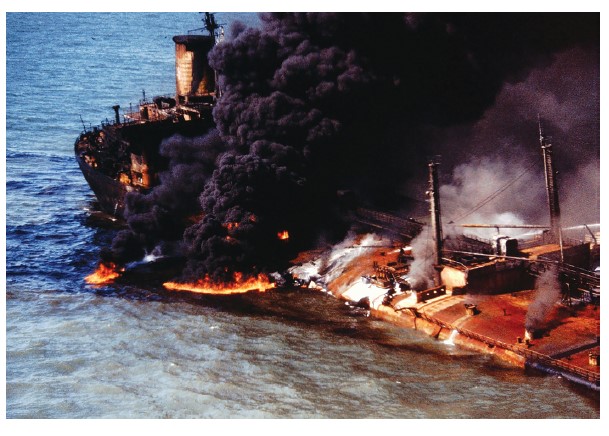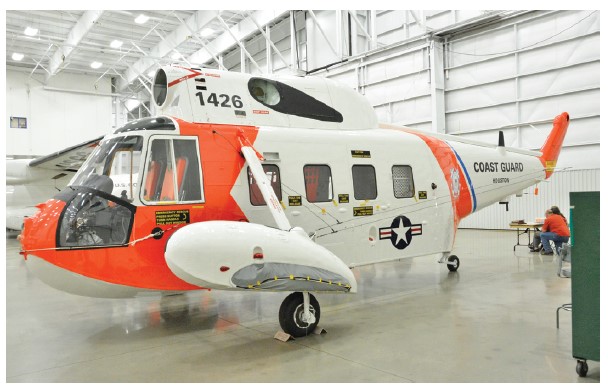As Galveston sleeps peacefully on a November night in 1979, a freighter glides silently along the eastern tip of the island. In their slumber, island residents were oblivious to the events about to unfold, but by daybreak, Galveston would be making national headlines.
The freighter Mimosa had exited the Houston Ship Channel and passed Galveston by a few miles, just reaching the international waters of the Gulf of Mexico. In the predawn darkness, traveling at full speed, she slammed into the starboard side of an anchored tanker, ripping an 8x15-foot gash in the tanker’s side. This tanker was the Burmah Agate and she was carrying over 10 million gallons of Nigerian crude oil.
When the two ships collided, crude instantly began gushing from the wound of the Burmah Agate. The collision simultaneously ignited the oil, setting it ablaze. Flames then leapt onto the freighter Mimosa, setting that ship ablaze as well. Galveston was barely waking up at 5am when a 3-man Coast Guard helicopter crew based at Ellington Field in Houston was alerted to a critical rescue mission off the coast of Galveston.
Their helicopter was a Sikorsky Seaguard HH-52A, identified as Coast Guard 1426. As the CG-1426 lifted into the darkness of early morning, the crew could already see an eerie glow over the southeastern horizon even though the accident site was over 40 miles away. Twenty-three minutes later, CG-1426 arrived at the site.
The scene the crew witnessed exceeded anything they could have imagined. The enormous tanker was now completely engulfed in flames that reached high into the sky. The Guard’s initial presumption was that there could be no survivors, that all had most likely been incinerated. A command was given to fly closer to the Burmah Agate to confirm.
They flew the helicopter 200 feet above the water in search of survivors, passing along the port side of the ship away from the flames. Suddenly, one of the Burmah Agate’s tanks exploded. The massive explosion narrowly missed blowing the helicopter out of the air, while sending a massive ball of fire towering into the sky. Seconds later, the junior crew member keenly spotted two human figures, alive, high on the ship’s air castle.
The intensity of the heat radiating from the raging inferno was barely tolerable, but the pilot defiantly hovered the craft over the ship, at times blinded by billows of black smoke. Determined to save the two seamen, command was given to lower the basket. In a few tense minutes, the survivors were swiftly lifted to the safety of CG-1426. The helicopter was then quickly maneuvered sideways, away from the flaming ship.
 It was at this harrowing moment that the helicopter unexpectedly dropped from the sky. For a terrifying second, the craft was out of control and falling, but as testimony to the pilot’s quick reflex and skill, he was able to regain control.
It was at this harrowing moment that the helicopter unexpectedly dropped from the sky. For a terrifying second, the craft was out of control and falling, but as testimony to the pilot’s quick reflex and skill, he was able to regain control.
The craft had gained lift from the heat and updrafts, but when moving away, it had lost this lift and briefly fallen from its position. The crew had narrowly escaped death once again.
The sun had slowly risen over the horrific scene, and Galveston was now fully aware that something was seriously wrong. From the beach, a huge black smoke plume covered the horizon, signaling the location where dozens of men had already perished.
The CG-1426 then fled to assist the Mimosa which was burning as well. The ship’s crew was spotted on the port bridge wing, all tightly bunched together, waiting in fear. The basket was lowered once again. This time, the rescue attempt suddenly went out of control.
As soon as the basket was lowered, the terrified crewmembers all lunged for the basket, grabbing at it, attempting to climb on to it all at once, and jeopardizing mission and crew. Their panic and desperation were understandable, from fear of being burned alive by the encroaching flames.
Twelve of the ship’s crew were pulled aboard. Now CG-1426 had problems of its own, as the craft was seriously overloaded. The chopper lumbered to a nearby drilling rig to unload the survivors. There would be two more trips to the Mimosa, rescuing a total of 24 men. CG-1426 was now dangerously low on fuel. It would need to be relieved by a second helicopter.
These rescues were unimaginably challenging. The pilots were trying to hover above a moving ship, travelling in circles, while dangling a basket from a long line among the ship’s masts, rigging, and antennas. The wind compounded problems as did the intense heat and updrafts of the flames. Worst of all, the flaming Mimosa was now unmanned and circling the gulf waters off Galveston.
There was no way to board the burning ship to bring it under control, so it circled menacingly for days like a crazed zombie ship. Completely out of control, it dragged its anchor, threatening to rupture any one of many undersea natural gas lines. Finally, a plan was devised to secure the fated ship.
Cables were lowered into the water at the rear of the unmanned ship with the intention of tangling them in the ships propeller to slow it down and stop it. This plan was a success. The Coast Guard Cutter Valiant spearheaded this mission and the Mimosa was finally stopped. Meanwhile, the Burmah Agate continued to burn.
Days turned into weeks as international help arrived to the dreadful scene off Galveston. Specialized skimmer boats arrived from the Netherlands along with firefighting boats. Courageous crews attempted to cool the ship down and extinguish the flames, even as repeated explosions threatened the workers.
 Miles of containment booms were laid out to stop the spread of drifting crude oil into the Gulf and stretched along the shoreline to protect the fragile bay estuaries. At times, the efforts were hampered as the booms were melted by the extreme heat.
Miles of containment booms were laid out to stop the spread of drifting crude oil into the Gulf and stretched along the shoreline to protect the fragile bay estuaries. At times, the efforts were hampered as the booms were melted by the extreme heat.
Over 2,000 barrels of crude oil were removed from Galveston’s beaches. While countless civilian heroes rescued and cleaned hundreds of stricken birds, the crew members of CG-1426 were accordingly decorated for their heroism at sea.
After 69 days, the Burmah Agate fire finally burned itself out. The ordeal began on November 1, 1979 and lasted until January 8 of the following year. The remaining oil was pumped from the ship. It was then towed to Brownsville to be scrapped.
Today, there is scarcely a trace of oil on Galveston’s beaches, revealing that nature has an amazing ability to heal itself over time. However, the story of the Burma Agate has not been forgotten, and in fact it is told each day. At the Smithsonian National Air and Space Museum, Coast Guard Helicopter 1426 is on public display at the Udvar-Hazy Center in Northern Virginia along with the heroic tale of its crew on that fateful November day off the coast of Galveston Island.